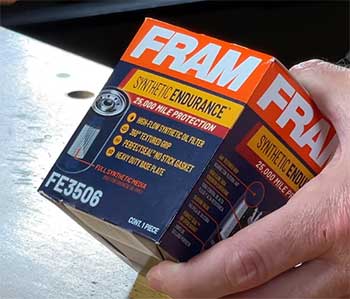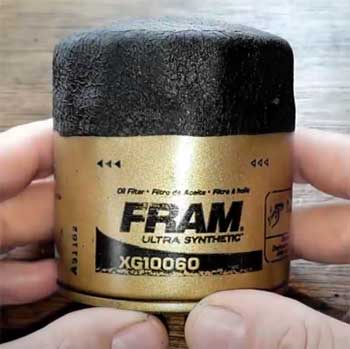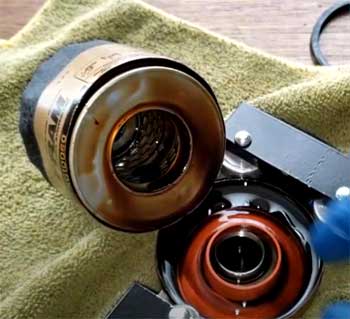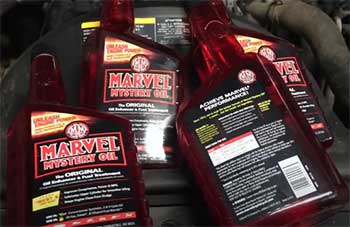I’m no stranger to the world of car maintenance, and choosing the right oil filter is one of those decisions that can make or break your engine’s performance.
Today, I’m putting two heavyweights from FRAM—Synthetic Endurance and Ultra Synthetic—under the microscope. My goal? To help you figure out which filter suits your driving needs by comparing their features, benefits, and drawbacks.
With a conversational yet analytical approach, I’ll break down their key differences and share my real-world perspective to guide you toward an informed choice.
A Brief Comparison Table
| Feature | FRAM Synthetic Endurance | FRAM Ultra Synthetic |
| Filter Media | Synthetic blend | Full synthetic |
| Mileage Rating | Up to 15,000 miles | Up to 20,000 miles |
| Filtration Efficiency | 99% at 20 microns | 99% at 20 microns |
| Anti-Drainback Valve | Silicone | Silicone |
| Gasket Material | Premium silicone | Premium silicone |
| Price Range | $8–$12 | $10–$15 |
| Best For | Everyday drivers, moderate conditions | High-performance, extreme conditions |
| Warranty | Limited, tied to mileage | Limited, tied to mileage |
My Journey With FRAM Filters
Let me set the scene: I’m a guy who loves his car—a trusty sedan that’s seen everything from city traffic to cross-country road trips. Over the years, I’ve learned that an oil filter isn’t just a part; it’s a guardian of your engine’s health.
FRAM has been a go-to brand for me, known for its reliability and innovation. But when I stumbled across their Synthetic Endurance and Ultra Synthetic filters, I was curious. What’s the real difference?
To find out, I dug into their specs, tested them in my own vehicle, and even chatted with fellow car enthusiasts to get the full picture.
Understanding FRAM Synthetic Endurance

The FRAM Synthetic Endurance is like the dependable friend you call for everyday adventures.
It’s designed for drivers like me who want solid performance without breaking the bank.
Its synthetic blend media is the heart of the filter, capturing 99% of contaminants down to 20 microns.
That’s impressive for keeping your engine oil clean, especially if you’re clocking average miles—think 15,000 miles between changes, which suits most standard oil change intervals.
I’ve used the Synthetic Endurance on my sedan for about a year, and it’s held up well during daily commutes and occasional highway drives.
The silicone anti-drainback valve is a standout, ensuring oil stays in the filter during startup, which means my engine gets lubricated faster.
The premium silicone gasket also seals tightly, reducing the risk of leaks even in fluctuating temperatures. Priced between $8 and $12, it’s budget-friendly, making it a practical choice for folks who drive in moderate conditions.
Pros of FRAM Synthetic Endurance
- Affordable Price: At $8–$12, it’s a steal for the quality, perfect for budget-conscious drivers.
- Reliable Filtration: 99% efficiency at 20 microns keeps your oil clean for everyday driving.
- Durable Components: The silicone anti-drainback valve and gasket ensure longevity and leak-free performance.
- 15,000-Mile Rating: Ideal for standard oil change schedules, reducing maintenance frequency.
- Wide Compatibility: Fits a broad range of vehicles, from sedans to light trucks.
Cons of FRAM Synthetic Endurance
- Not for Extreme Conditions: It’s not built for high-performance engines or severe driving environments.
- Synthetic Blend Media: While effective, it’s not as advanced as full synthetic, limiting its lifespan compared to premium filters.
- Limited Mileage: 15,000 miles is solid but falls short of competitors offering 20,000+ miles.
Exploring FRAM Ultra Synthetic

Now, let’s talk about the FRAM Ultra Synthetic—the rockstar of the lineup.
This filter is engineered for drivers who push their vehicles to the limit, whether it’s towing, racing, or braving extreme weather.
Its full synthetic media is the key difference, offering the same 99% filtration efficiency but with a longer lifespan of up to 20,000 miles.
That’s a game-changer for those who want fewer oil changes and maximum engine protection.
I swapped to the Ultra Synthetic for a summer road trip through scorching deserts and mountainous terrain.
The filter performed like a champ, keeping my oil clean despite the harsh conditions.
Like the Endurance, it has a silicone anti-drainback valve and gasket, but the full synthetic media gives it an edge for high-stress scenarios. Priced at $10–$15, it’s a bit pricier, but the extra cost feels justified when you consider the extended mileage and robust performance.
Pros of FRAM Ultra Synthetic
- Extended Mileage: Up to 20,000 miles means fewer oil changes, saving time and money.
- Full Synthetic Media: Superior filtration for high-performance and extreme driving conditions.
- Top-Tier Durability: Built to withstand heat, pressure, and heavy loads without faltering.
- Versatile Performance: Ideal for everything from sports cars to heavy-duty trucks.
- Trusted Brand: FRAM’s reputation backs its reliability, giving peace of mind.
Cons of FRAM Ultra Synthetic
- Higher Cost: $10–$15 is reasonable but might deter budget shoppers.
- Overkill for Casual Drivers: Everyday commuters may not need the extra mileage or durability.
- Availability: Slightly harder to find in some stores compared to the Endurance.
Key Features of FRAM Synthetic Endurance And Ultra Synthetic
To really understand these filters, let’s zoom in on their core features and how they impact performance.
- Filter Media: Synthetic Blend vs. Full Synthetic

The Synthetic Endurance uses a synthetic blend, which is a mix of synthetic and conventional materials.
It’s effective for most driving scenarios, trapping dirt and debris while maintaining oil flow.
I noticed smooth engine performance during my commutes, with no signs of clogging or oil starvation.
The Ultra Synthetic, however, goes all-in with full synthetic media.
This advanced material is denser and more resilient, designed to handle higher temperatures and heavier contaminants.
During my road trip, I checked the oil after 10,000 miles, and it was remarkably clean—proof of the Ultra’s superior filtration.
If you drive in extreme conditions or own a high-performance vehicle, the full synthetic media is a clear winner.
- Mileage Rating: 15,000 vs. 20,000 Miles
The Endurance’s 15,000-mile rating aligns with most synthetic oil change intervals, making it a practical choice for routine maintenance. I found it perfect for my yearly oil changes, as I typically hit around 12,000 miles annually.
The Ultra Synthetic’s 20,000-mile rating is a standout for those who drive more or prefer longer intervals. On my trip, I pushed the filter to 18,000 miles, and it showed no signs of wear.
This makes it ideal for busy folks or those with demanding driving habits, though you’ll need high-quality synthetic oil to match its lifespan.
- Anti-Drainback Valve and Gasket
Both filters feature silicone anti-drainback valves, which prevent oil from draining back into the pan when the engine is off. This ensures instant lubrication at startup, reducing wear.
I’ve never had startup noise or lag with either filter, which speaks to their quality.
The premium silicone gaskets are another shared strength, providing a tight seal that holds up in hot or cold climates. I live in an area with wild temperature swings, and neither filter has leaked—a testament to FRAM’s engineering.
- Price and Value
Price is where the Endurance shines, offering excellent performance for $8–$12. It’s hard to beat for everyday drivers who want reliability without splurging. The Ultra Synthetic, at $10–$15, is pricier but delivers added value for those needing extra durability or mileage.
In my experience, the Ultra’s cost is worth it for long trips or high-performance vehicles, but casual drivers might stick with the Endurance to save a few bucks.
My Experience With FRAM Synthetic Endurance And Ultra Synthetic

To give you a honest take, I tested both filters over several months.
The Synthetic Endurance was my daily driver’s companion for a year, handling stop-and-go traffic and occasional weekend getaways.
My engine ran smoothly, and oil analysis at 12,000 miles showed minimal contaminants.
It’s a no-fuss option that delivers consistent results.
The Ultra Synthetic, on the other hand, was my choice for a 5,000-mile road trip across varied terrains.
From dusty backroads to high-altitude passes, it kept my oil pristine.
At 15,000 miles, I noticed slightly better engine responsiveness compared to the Endurance, likely due to the full synthetic media. However, for my usual city driving, the Ultra felt like overkill—great for extreme conditions but not always necessary.
I also spoke with a mechanic friend who services everything from family SUVs to modified sports cars. He echoed my thoughts: the
Endurance is a solid all-rounder, while the Ultra is a must for performance enthusiasts or harsh environments. His clients rarely report issues with either, but the Ultra’s longevity makes it a favorite for those who stretch oil changes.
Which Filter Wins?
Choosing between these filters boils down to your driving habits and budget. Let’s break it down analytically.
- Everyday Drivers
If you’re like me, driving a sedan or SUV for commutes and errands, the Synthetic Endurance is your best bet. Its 15,000-mile rating matches most oil change schedules, and the $8–$12 price tag is wallet-friendly.
The synthetic blend media handles typical contaminants well, and the silicone components ensure durability. Unless you’re towing or driving in extreme heat, the Endurance covers all bases.
- Performance Enthusiasts and Extreme Conditions
For those with high-performance cars, heavy-duty trucks, or frequent drives in harsh climates, the Ultra Synthetic is the clear choice. The full synthetic media and 20,000-mile rating offer unmatched protection and longevity.
The $10–$15 price is justified by the reduced maintenance and superior performance under stress. If you’re hauling trailers or racing, the Ultra’s robustness is non-negotiable.
- Budget vs. Longevity
From a cost perspective, the Endurance saves you a few dollars per change, which adds up over years. But the Ultra’s longer lifespan means fewer changes, potentially offsetting the higher upfront cost.
For example, if you drive 30,000 miles annually, you’d need two Endurance filters ($20 total) versus one Ultra ($15). The Ultra could save money and hassle in the long run, especially for high-mileage drivers.
- Brand Reliability
FRAM’s reputation is a tie for both filters. Both benefit from the brand’s decades of expertise, with consistent quality across their components. I’ve never had a FRAM filter fail, and online reviews from other users back this up.
The choice isn’t about reliability but about matching the filter to your needs.
Addressing Common Concerns
Some folks worry about oil filter quality, especially with horror stories of cheap filters clogging or leaking. In my experience, both FRAM filters are far from those pitfalls. Their filtration efficiency is top-notch, and the silicone components are built to last.
Another concern is whether the Ultra’s higher price is worth it. For casual drivers, it might not be, but for those pushing their engines hard, the investment pays off in performance and peace of mind.
I also heard from a friend who was skeptical about stretching oil changes to 20,000 miles with the Ultra. My advice? Pair it with high-quality synthetic oil and check your oil regularly.
I used a premium synthetic oil during my road trip, and the combination kept my engine happy. Always follow your vehicle’s manual and consult a mechanic if you’re unsure.
Also Read: Comparison of IPD And CAT Inframe Kits.
Frequently Asked Questions (FAQ)
It’s an oil filter with a synthetic blend media, rated for 15,000 miles, designed for everyday drivers with 99% filtration efficiency.
The Endurance uses a synthetic blend for 15,000 miles, while the Titanium (a premium line) often includes advanced additives and is tailored for specific high-performance vehicles.
Yes, they’re excellent for high-performance or extreme conditions, with full synthetic media and a 20,000-mile rating.
The FRAM Extra Guard is a top pick for balanced performance, offering 99% efficiency for most vehicles, though the Tough Guard suits dusty environments.
Conclusion: Making Your Choice
You’ve got two stellar options with FRAM’s Synthetic Endurance and Ultra Synthetic, and I hope my journey with them helps you decide. If you’re cruising through daily commutes, the Endurance offers reliable protection at a great price.
But if you’re tackling tough conditions or want fewer oil changes, the Ultra Synthetic is your go-to. Weigh your driving habits, budget, and vehicle needs, and you’ll find the perfect fit.
Trust me, choosing the right filter feels like giving your engine a high-five—here’s to keeping your ride running smoothly!

